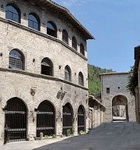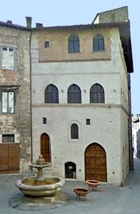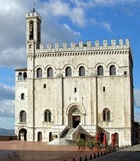

Civitas de Novo (late 12th century)
A new civic and episcopal complex was established on the slopes of Monte Ingino in the late 12th century. The prime mover for this development seems to have been Bishop Benedetto Bentivoglio:
-
✴In 1188, Pope Clement III gave him permission to translate the relics of the saints of Gubbio (presumably those of SS Marianus and James as well as the body of the future St Ubaldus) from the “antiqua civitate” to the site on the mountain, where the “civitas de novo” had been constructed.
-
✴Shortly thereafter, Bishop Bentivoglio conceded to the canons a new site for their palace “in quo constructum est” (on which was constructed) the new Duomo of SS Mariano e Ubaldo and the episcopal palace.
The diploma (1191) in which the Emperor Henry VI granted important privileges to Gubbio also included retrospective permission for the construction of the “novam civitatem” on Monte Ingino. The development must have been largely complete by 1203, when a document was agreed “ante ecclesiam ... in platea ubi fit contio” (in front of the cathedral ... in the square in which meetings are held). It is clear that, at least by that time, the new city housed to civic as well as the eclesiastical authorities: another document of 1203 was notarised “sub tracandam palatii communis Eugubini” ( under the covered loggia of Palazzo Comunale of Gubbio). Traces of this palace survive under what is now Palazzo Ducale (see below).
The new Duomo and Palazzo Comunale opened onto the “platea communis”, which was bounded by the new city wall and a city gate, Porta di Santa Agnese.
Palazzo Comunale (ca. 1203)
As noted above, a document of 1203 was notarised “sub tracandam palatii communis Eugubini” ( under the covered loggia of Palazzo Comunale of Gubbio).
Excavations under Palazzo Ducale have uncovered a contemporary civic complex, which comprised Palazzo Comunale and its tower. (The nearby Palazzo della Guardia was converted to be part Palazzo Ducale itself).
[Details of the excavated area]
This civic complex became redundant when the magistrates moved to the new civic palaces below in 1349-50.
Maestà (1321)
An artist called Palmerino (possibly Palmerino di Guido) was commissioned to paint this fresco for the “Salecta Dominorum Consolorum” (a room in the old Palazzo dei Consoli) [Traces survive in Palazzo Ducale ??]
Guelf Palaces (early 14th century)
Two quasi-public palaces were built in the “vicus ultra aquam” (the area of the city on the lower bank of the Camignano - see the page on the City Gates and Walls of Gubbio). This area had been developed as a stronghold of the noble families of Gubbio, who were mostly Ghibellines. Paolo Micalizzi (referenced below) suggests that they were built in the period of Ghibelline weakness in the first half of the 14th century. They probably continued to be used to defend the city from Ghibelline incursions until 1384, when Gubbio passed to the Counts of Urbino.
Palazzo del Capitano

The palace is on three floors: public rooms were on the ground floor, while the top floor accommodated the city militia.
The palace now houses a small private museum of instruments of torture.
Palazzo del Bargello

The palace passed to the Commune in 1870. It is now the headquarters of the Società Balestrieri and houses the Museo della Balestra (museum of crossbows): the Palio della Balestra is an ancient festival held each May in honour of St Ubaldus.
New Public Palaces
In 1321, the Consiglio Generale (ruling council) of Gubbio resolved to build two new public palaces in a new civic centre:
-
✴Palazzo del Popolo or dei Consoli; and
-
✴Palazzo del Podestà.
The site chosen was at the meeting point of the four administrative quarters of the city. The guiding hand in this development was that of Cante Gabrielli, who supervised the initial preparatory work. (He died at an unknown date after October 1322). This work seems to have come to an abrupt halt when the Ghibelline Giovanni Gabrielli took the city in 1350.
The palaces remained in use after Gubbio passed to the Counts of Montefeltro in 1384, albeit that the power of the magistrates was circumscribed. The piazza between the two palaces must have been in a very incomplete state: the four great arches what is now Via Ubaldo Baldassini that support the current pensile structure were not built until 1480-3, and the steps up from this level were only completed in 1491.
A loggia along the edge between the two palaces, which was built in 1520 to shelter the stalls of merchants, was demolished in 1839.
Palazzo dei Consoli (1332-42)


The portal contains two inscriptions:
-
✴the inscription on the architrave (illustrated above), which flanks the arms of Gubbio, the Papal States and King Robert of Anjou, records that construction of the portal had begun in 1332 and that the architrave had been laid in 1336; and
-
✴the inscription around the lunette adds that it was put in place in 1337, and that Angelo da Orvieto was responsible for the work.
The statutes of 1338 resolved that the palace should be used by the magistrates, notwithstanding the fact that it was still in construction. The exiled artist Guiduccio Palmeruccio was allowed to return to Gubbio in 1342 on condition that he executed a number of frescoes in the palace, which suggests that construction was largely complete by that time. While most of these frescoes (including an Annunciation and an Assumption of the Virgin) have been lost, others that survive might belong to this programme. The city magistrates definitively moved into the palace in 1349.
The campanile was finished in 1389.
Madonna and Child with saints (1495)
This fresco by Bernardino di Nanni dell’ Eugenia in the lunette above the main entrance depicts the Madonna and Child with SS John the Baptist and Ubaldus. [The date is written in the vernacular] Benedetto Nucci repainted it in the 16th century.
Interior
The ground floor is largely taken up by the huge Sala dell’ Arengo, which once housed the assembly of the Commune. The stairs at the back of the room lead to the former sacristy and then the former Cappella Palatina. Further up the stairs, a room on the right now houses the Commune’s ceramics collection. It leads to a passage that contains the medieval toilets, which (unusually for this period) drained into a sewer through clay pipes that were built into the walls during construction. Many of the rooms here now house the exhibits of the the Museo Civico.
The top floor now comprises the five rooms that house the exhibits of the Pinacoteca Civica. The room top of the stairs, the so-called Sala della Fontana, has a fountain at its centre and a sink with four taps in the right wall, both of which were served by the medieval aqueduct. This sophisticated plumbing system was installed in 1350. A door to the right at the top of the stairs leads to the loggia, which offers a splendid view of the valley below.
Palazzo del Podestà (ca. 1338-49)

The building behind the palace mentioned above was rebuilt in 1866 and the palace itself was restored in 1867-72. Since then, the complex has housed the Local Authority.
[Later Palazzo del Pretorio]
The interior of the original building is composed of three large halls one above the other, each of which has an imposing cross-vaulted ceiling supported by a single central pillar.
Read more:
S. Capannelli and G. Rossi (Eds), “La Platea Comunis e i Palazzi Pubblici di Gubbio” (2013) Gubbio
P. Micalizzi, ”Storia dell’ Architettura e della Città”, (2009) Gubbio
M. Belardi, “Il Palazzo dei Consoli a Gubbio e il Centro Urbano Trecentesco”, (2001) Perugia.
Return to Monuments of Gubbio.
Return to Walk I.

